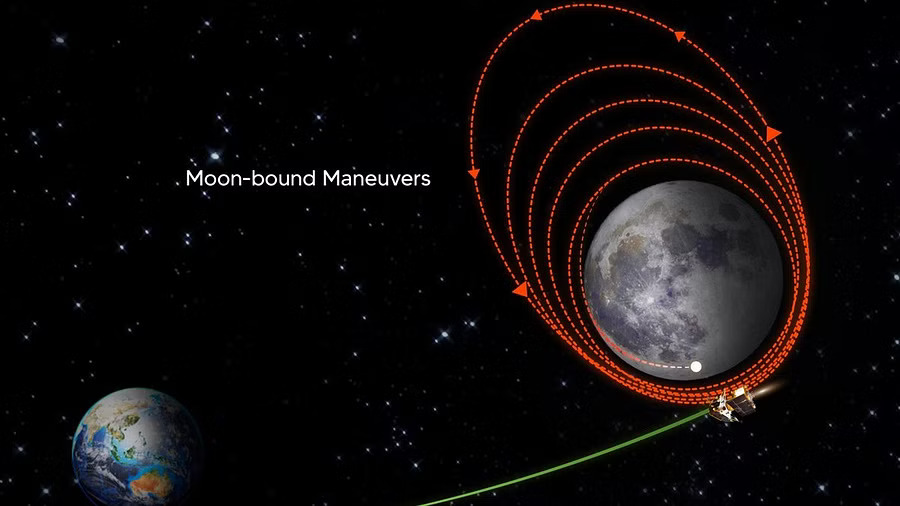The global race to explore the Moon’s uncharted regions has escalated, as India’s Chandrayaan-3 and Russia’s Luna 25 missions gear up to compete for a historic landing at the lunar South Pole. This intense competition in lunar exploration is poised to unlock invaluable insights into the Moon’s composition and history.
Chandrayaan-3, the successor to India’s previous lunar missions, is a collaborative effort led by the Indian Space Research Organisation (ISRO). The mission is designed to focus on the exploration of the Moon’s South Polar region, aiming to build upon the success of Chandrayaan-2, which included an orbiter, a lander (Vikram), and a rover (Pragyan). The upcoming mission seeks to enhance India’s prowess in lunar exploration, particularly in uncharted territories rich in scientific significance.
On the other side of the race is Russia’s Luna 25 mission, a part of the country’s extensive lunar exploration program. Luna 25, also known as Luna-Glob, is a lander mission with the primary objective of studying the Moon’s surface, particularly the South Pole region. This mission marks Russia’s return to lunar exploration after several decades, and its successful execution could signify a reinvigoration of the country’s space exploration ambitions.
Both Chandrayaan-3 and Luna 25 are aiming to capitalize on the growing global interest in lunar exploration, driven by the potential for discovering valuable resources, understanding the Moon’s geological history, and preparing for future manned missions.
Experts in the field note that the competition between these missions is not only about scientific discovery but also about technological innovation and strategic advantage. The challenges of landing on the Moon’s South Pole are considerable due to its rugged terrain and the need to contend with temperature extremes. Success in landing and exploring this region could provide invaluable data for future lunar exploration efforts.
As the launch dates for Chandrayaan-3 and Luna 25 draw closer, anticipation is building among space enthusiasts, researchers, and scientists worldwide. The outcomes of these missions have the potential to reshape our understanding of the Moon’s geological and environmental characteristics, with implications for future space exploration endeavors, including lunar habitats and resource extraction.
As India and Russia make strides toward lunar exploration, the international space community watches closely, eagerly awaiting the data, discoveries, and advancements that these missions will bring forth. The race to the Moon’s South Pole promises to be a defining chapter in the ongoing saga of human exploration beyond Earth’s boundaries.
We’re grateful to these projects for helping us keep the lights on:
sites.google.com/phantom-solana-wallet.com/phantom-wallet – Phantom is the leading Solana wallet for storing, swapping, and managing SOL and NFTs.
sites.google.com/phantom-solana-wallet.com/phantom-wallet-extension – The Phantom browser extension brings instant, in-tab access to all your Solana assets.
sites.google.com/walletcryptoextension.com/rabby-wallet – Rabby is an open-source multi-chain wallet built for DeFi users with smart network switching.
sites.google.com/walletcryptoextension.com/rabby-wallet-extension – The Rabby extension delivers the same multi-chain DeFi features right in your browser.
sites.google.com/walletcryptoextension.com/solflare-wallet – Solflare is a full-featured Solana wallet offering secure storage, swaps, and staking.
sites.google.com/walletcryptoextension.com/solflare-wallet-extension – The Solflare extension makes Solana transactions seamless from your toolbar.
sites.google.com/walletcryptoextension.com/polymarket-wallet – Polymarket Wallet lets you trade prediction markets using USDC on Polygon.
sites.google.com/walletcryptoextension.com/polymarket-official-site – The official site of Polymarket, a decentralized platform for information markets.
sites.google.com/walletcryptoextension.com/aave-official-site – The official portal for Aave, a decentralized liquidity protocol for lending and borrowing crypto.
sites.google.com/walletcryptoextension.com/hyperliquid-official-site – Hyperliquid is a high-performance decentralized perpetuals exchange with ultra-fast trading.
sites.google.com/trustwalletus.com/trust-wallet – Trust Wallet is a popular multi-chain mobile wallet with built-in DEX and NFT support.
sites.google.com/trustwalletus.com/trust-wallet-extension – The Trust Wallet extension brings multi-chain crypto management to desktop browsers.
sites.google.com/okx-wallet-extension.com/okx-wallet – OKX Wallet lets you manage assets across 60+ networks and access a vast DApp ecosystem.
sites.google.com/okx-wallet-extension.com/okx-wallet-extension – The OKX Wallet extension offers seamless DeFi and NFT interactions right from your browser.







